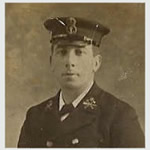Commemorated: | |||
| 1. Memorial: | Portsmouth Naval Memorial | 20 Hampshire | |
| 2. Book: | The (1921) Masonic Roll of Honour 1914-1918 | Pg.123 | |
| 3. Memorial: | The (1940) Scroll - WW1 Roll of Honour | 34A GQS | |
Awards & Titles: | |||
Service Life:
Campaigns:
- The First World War 1914-1918, World-wide.
| Unit / Ship / Est.: HMS Queen Mary |
Steaming in advance of Admiral Sir John Jellicoe's Grand Fleet, Beatty's battlecruisers, supported by the battleships of the 5th Battle Squadron, collided with Vice Admiral Franz Hipper's battlecruisers in the opening phases of the Battle of Jutland. Engaging at 3:48 PM on May 31, the German fire proved accurate from the outset. At 3:50 PM, Queen Mary opened fire on SMS Seydlitz with its forward turrets.As Beatty closed the range, Queen Mary scored two hits on its opponent and disabled one of Seydlitz's aft turrets. Around 4:15, HMS Lion came under intense fire from Hipper's ships. The smoke from this obscured HMS Princess Royal forcing SMS Derfflinger to shift its fire to Queen Mary. As this new enemy engaged, the British ship continued to trade hits with Seydlitz. At 4:26 PM, a shell from Derfflinger struck Queen Mary detonating one or both of its forward magazines. The resulting explosion broke the battlecruiser in half near its foremast. A second shell from Derfflinger may have hit further aft. As the after part of the ship began to roll, it was rocked by a large explosion before sinking. Of Queen Mary's crew, 1,266 were lost while only twenty were rescued. Though Jutland resulted in a strategic victory for the British, it saw two battlecruisers, HMS Indefatigable and Queen Mary, lost with nearly all hands. An investigation into the losses led to changes in ammunition handling aboard British ships as the report showed that cordite handling practices may have contributed to the loss of the two battlecruisers |
| Action : Jutland |
The Battle of Jutland was the largest naval battle of World War I, and the only full-scale clash of battleships in that war. It is considered to be the largest conventional naval battle in history. It was fought on 31 May - 1 June 1916, in the North Sea near Jutland, Denmark. The combatants were the Imperial German Navy's High Seas Fleet, commanded by Vice-Admiral Reinhard Scheer, and the British Royal Navy's Grand Fleet, commanded by Admiral Sir John Jellicoe. The German fleet's intention was to lure out, trap and destroy a portion of the Grand Fleet, as the German numbers were insufficient to engage the entire British fleet at one time. This formed part of a larger strategy to break the British blockade of the North Sea and to allow German mercantile shipping to operate. Meanwhile, the Royal Navy pursued a strategy to engage and destroy the High Seas Fleet, or keep the German force bottled up and away from Britain's own shipping lanes. Considered a tactical victory for the Germans but a resounding strategic victory for the British.
Detail :
My maternal Grandfather, George Wells Gibbs, was initiated into St Clair's Lodge No 2074, Landport, Portsmouth on 15th July 1912 and was raised on 15th Oct 1912. I don't know if he ever attained office in that Lodge as he died in the Great War in 1916, and is on the Roll of Honour in the Grand Lodge. He was born on 25 Oct 1879, married to Florence Kate Miller on 7 May 1901 and died at the Battle of Jutland on 31 May 1916, when his ship, HMS Queen Mary was sunk.
His official grave is the Portsmouth Naval War Memorial, and the inscription reads: "In Memory of Chief Armourer George Wells Gibbs, 342259 H.M.S. Queen Mary, who died on 31 May 1916". He joined the Navy at 19 on 8th Aug 1898, and was a plumber by trade. He was described on his records as 5ft 5 1/2 in, with brown hair, grey eyes, and fair completion, and 12 years later had grown to 5ft 8in! He was due to retire in 1910 with a pension. Probably because he was an armourer, he served on several ships, but one of his first ships was the HMS Duke of Wellington, a three masted wooden ship. He joined HMS Queen Mary on 4 Sept 1913 and left on 31 May 1916, being recorded as DD (discharged dead). He was said to be a very good piano player, and photographs show him to be a very dapper man. It is also said that, when the QM went down, it was not his tour of duty, but that he stood in for a colleague who had some form of family crisis to deal with. Source; Peter Hughes Lentune Lodge No 8743
Masonic :
| Type | Lodge Name and No. | Province/District : |
|---|---|---|
| Mother : | St Clair No. 2074 E.C. | Hampshire & IOW |
Initiated | Passed | Raised |
15th July 1912 | 9th August 1912 | 15th October 1912 |
Source :
The project globally acknowledges the following as sources of information for research across the whole database:
- The Commonwealth War Graves Commission
- The (UK) National Archives
- Ancestry.co.uk - Genealogy, Family Trees & Family History online
- ugle.org.uk - The records of the United Grand Lodge of England including the Library and Museum of Freemasonry
Additional Source:
- Founder Researchers : Paul Masters & Mike McCarthy
- Researcher : Bruce Littley

